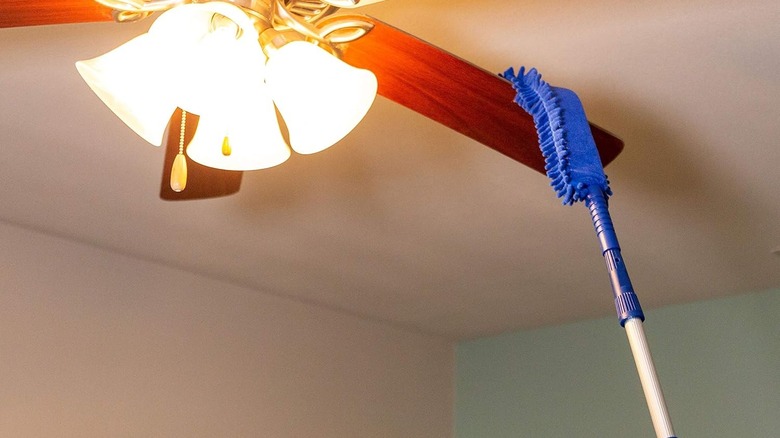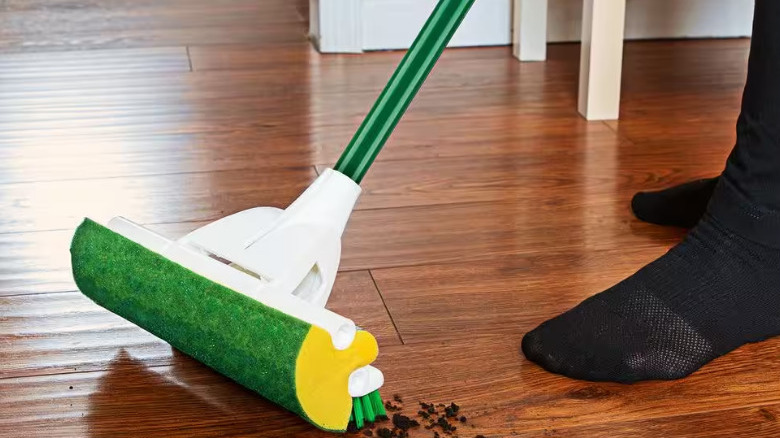The Best Way To Clean A Cove Ceiling
We may receive a commission on purchases made from links.
Cove ceilings might not be common, but they pack a large architectural punch. They are ceilings that curve where your wall and ceiling meet, creating a nice, rounded shape. It makes the space appear softer, more architectural, and elegant due to the craftsmanship it takes to create that curve. But while they add a lot to a room, are they worth the upkeep? Since cove ceilings aren't typical, not everyone knows how to clean them. As it turns out, it's the same as cleaning a flat ceiling. For maintenance, you want to perform a quarterly dusting with a vacuum hose attachment or duster, and then deep clean it once a year with a damp mop.
The only difference between how to clean a cove versus a flat ceiling might be the tools. Since a cove ceiling has a rounded curve, it might be more challenging to use flat mops on them, such as Swiffers. However, you can easily work around this dilemma by using a more flexible mop head that can bend with its curves, such as a sponge mop. Here is an in-depth look at how to clean cove ceilings.
How to maintenance-clean a cove ceiling
If you're performing your quarterly maintenance clean, then all you need to do is wipe down the cove ceiling to remove any light grime, dust, or rogue spiderwebs. To do so, invest in a telescopic duster that will allow you to reach the ceiling without having to climb on any ladders. You want to choose one that is lightweight so your arms and shoulders don't cramp while holding it, and one that comes with several different attachments so you can achieve different kinds of dusting techniques. A great option is the U.S. Duster Company Triple Action Microfiber Dusting Kit, which you can get on Amazon for $47. It's made from aluminum which makes it very lightweight, and it can extend to 20 feet, which will help you reach even the highest of curves. It also comes with three duster attachments: a brush head duster that is great for removing spider webs, and a chenille head for sweeping away dust, and a chenille duster that picks up stubborn grime clinging to the paint. The last two options can bend to any angle (as pictured above), allowing you to follow the curves of the ceiling.
Once you use the duster to remove any spiderwebs and the first layer of dust, switch to your vacuum hose attachments to give it a deeper clean. Use the flat-head brush tool to run it up and down the curves of the ceiling, and then across the flat part of the ceiling. This should be sufficient to remove any remaining dust.
How to deep clean a cove ceiling
It's recommended to deep clean your ceiling once a year with a wet mop, and that includes cove ceilings. For the solution, all you need to do is mix a few drops of dish soap into a warm bucket of water. You don't want it to be overly soapy, or else you will leave behind residue on the ceiling. For the mop, use a flexible sponge mop so it can easily follow the curves of the cove molding. A great one to consider is the Nitty Gritty Roller Sponge Mop, which costs $25 at Home Depot. Rather than being flat like a Swiffer, it has a curved head, which will make cleaning the contours of your ceiling a breeze.
To not oversaturate the sponge, you can either dunk it into your bucket solution and then wring the sponge until it's just lightly damp, or you can pour the solution into a spray bottle and lightly saturate the sponge yourself. You don't want the mop to be sopping, or else you will add too much moisture to the wall, and it will drip on the floor below. Once saturated, move the mop across the ceiling until the entire expanse is clean. If it looks overly damp, grab a second unused sponge mop or put a thick cleaning towel over the damp one and wipe it dry.


